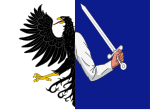This article needs additional citations for verification. (September 2014) |
Connacht
Connachta[1] | |
|---|---|
 | |
| Coordinates: 54°N 9°W / 54°N 9°W | |
| State | Ireland |
| Counties | Galway Leitrim Mayo Roscommon Sligo |
| Government | |
| • Teachtaí Dála | 6 Independent TDs 5 Fine Gael TDs 4 Fianna Fáil TDs 4 Sinn Féin TDs |
| • MEPs[a] | 2 Fine Gael MEPs 1 Sinn Féin MEP 1 Independent MEP |
| Area | |
| • Total | 17,713 km2 (6,839 sq mi) |
| • Rank | 4th |
| Population (2022)[2] | |
| • Total | 589,338 |
| • Rank | 4th |
| • Density | 33/km2 (86/sq mi) |
| Time zone | UTC±0 (WET) |
| • Summer (DST) | UTC+1 (IST) |
| Eircode routing keys | Beginning with F, H, N (primarily) |
| Telephone area codes | 07x, 09x (primarily) |
| ISO 3166 code | IE-C[3] |
| a. ^ Connacht is part of the Midlands–North-West constituency; the five Connacht counties contain 36.2% of the population of this constituency.[4] | |
Connacht or Connaught (/ˈkɒnɔːt, ˈkɒnə(x)t/ KON-awt, KON-ə(kh)t;[5][6][7] Irish: Connachta [ˈkʊn̪ˠəxt̪ˠə] or Cúige Chonnacht [ˌkuːɟə ˈxʊn̪ˠəxt̪ˠ]), is one of the four provinces of Ireland, in the west of Ireland. Until the ninth century it consisted of several independent major Gaelic kingdoms (Uí Fiachrach, Uí Briúin, Uí Maine, Conmhaícne, and Delbhna).
Between the reigns of Conchobar mac Taidg Mór (died 882) and his descendant, Aedh mac Ruaidri Ó Conchobair (reigned 1228–33), it became a kingdom under the rule of the Uí Briúin Aí dynasty, whose ruling sept adopted the surname Ua Conchobair. At its greatest extent, it incorporated the often independent Kingdom of Breifne, as well as vassalage from the lordships of western Mide and west Leinster. Two of its greatest kings, Tairrdelbach Ua Conchobair (1088–1156) and his son Ruaidri Ua Conchobair (c. 1115–1198) greatly expanded the kingdom's dominance, so much so that both became High King of Ireland.
The Kingdom of Connacht collapsed in the 1230s because of civil war within the royal dynasty, which enabled widespread Hiberno-Norman settlement under Richard Mór de Burgh, 1st Baron of Connaught, and his successors. The Norman colony in Connacht shrank from c. 1300 to c. 1360, with events such as the 1307 battle of Ahascragh (see Donnchad Muimnech Ó Cellaigh), the 1316 Second Battle of Athenry and the murder in June 1333 of William Donn de Burgh, 3rd Earl of Ulster, all leading to Gaelic resurgence and colonial withdrawal to towns such as Ballinrobe, Loughrea, Athenry, and Galway. Well into the 16th century, kingdoms such as Uí Maine and Tír Fhíacrach Múaidhe remained beyond English control, while many Norman families such as de Burgh, de Bermingham, de Exeter, de Staunton, became entirely Gaelicised. Only in the late 1500s, during the Tudor conquest of Ireland, was Connacht shired into its present counties.
Connacht's population was 1,418,859 in 1841.[8] Then came the Great Famine of the 1840s, which began a 120-year decline to under 400,000. The province has a population of just under 590,000 according to the preliminary results of the 2022 census.[9]
Anglicisation was less prominent in the west of Ireland, and Connacht today has the highest number of Irish language speakers among the four Irish provinces. Currently, the total percentage of people who consider themselves as Irish speakers in Connacht is 39.8% (more than 202,000 persons).[10] There are Gaeltacht areas in Counties Galway and Mayo.
The province of Connacht has no official function for local government purposes, but it is an officially recognised subdivision of the Irish state. It is listed on ISO-3166-2 as one of the four provinces of Ireland and "IE-C" is attributed to Connacht as its country sub-division code.[3] Along with counties from other provinces, Connacht lies in the Midlands–North-West constituency for elections to the European Parliament.
- ^ "Connacht (also Connaught)". foclóir.ie. Foras na Gaeilge. Retrieved 16 December 2022.
- ^ "Population by province". Central Statistics Office. 2016. Archived from the original on 31 October 2018. Retrieved 30 October 2018.
- ^ a b "ISO 3166-2 Newsletter II-1 (including Irish language names for provinces and counties)" (PDF). International Organization for Standardization (ISO). 19 February 2010. p. 20. Archived (PDF) from the original on 3 February 2017. Retrieved 30 December 2012.
- ^ Census of Ireland 2016: 550,742 out of 1,521,592 total.
- ^ "Connacht" (US) and "Connacht". Lexico UK English Dictionary. Oxford University Press. Archived from the original on 11 February 2020.
- ^ "Connacht". Merriam-Webster.com Dictionary. Merriam-Webster. Retrieved 11 January 2019.
- ^ "Connacht". The American Heritage Dictionary of the English Language (5th ed.). HarperCollins. Retrieved 11 October 2019.
- ^ The National Cyclopaedia of Useful Knowledge, Vol IV. London: Charles Knight. 1848. p. 858.
- ^ "Geographic Changes". Central Statistics Office. 23 June 2022. Retrieved 3 January 2023.
- ^ "Percentage of Irish Speakers and Non-Irish Speakers Aged 3 Years and Over 2011 to 2016 by Sex, County and City, Statistical Indicator and Census Year". Central Statistics Office. Archived from the original on 10 July 2017. Retrieved 31 October 2018.

